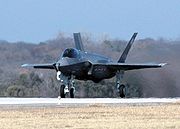Turkish Air Force
| Turkish Air Force Türk Hava Kuvvetleri |
|
|---|---|
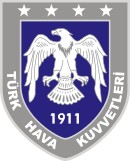 Seal of the Turkish Air Force |
|
| Founded | 1909 - 1911 |
| Country | |
| Size | 60,100 personnel (2008 est.)[1] 930+ aircraft |
| Part of | Turkish Armed Forces |
| HQ | Ankara |
| Engagements | Balkan Wars First World War Turkish War of Independence Korean War Cyprus War Operation Provide Comfort Operation Deliberate Force Operation Northern Watch Operation Allied Force Operation Enduring Freedom Operation Northern Iraq Operation Sun |
| Commanders | |
| Commander | General Hasan Aksay |
| Chief of the General Staff | General İlker Başbuğ |
| Insignia | |
| Roundel |  |
| Aircraft flown | |
| Attack | - F-16 Fighting Falcon - F-4E 2020 Terminator - F-4E Phantom II - F-5 2000 |
| Electronic warfare |
- Boeing 737 AEW&C - CN-235 EW |
| Fighter | - F-16 Fighting Falcon |
| Interceptor | - F-16 Fighting Falcon |
| Reconnaissance | - RF-4E Phantom II - Heron - MQ-9 Reaper - MQ-1 Predator - RQ-7 Shadow 600 - Searcher II - Aerostar - GNAT 750 - I-GNAT ER |
| Trainer | - T-38 - SF-260 - T-37 - T-41 |
| Transport | - C-130 - C-160 - CN-235 - Cougar - UH-1H |
The Turkish Air Force (Turkish: Türk Hava Kuvvetleri) is a branch of the Turkish Armed Forces. It is one of the oldest air forces in the world, and with a current inventory of more than 930 aircraft, ranks 3rd in NATO in terms of fleet size, behind the USAF and RAF. Supported by the TuAF's long-range in-flight refueling capability, the fighter jets of the Turkish Air Force can participate in international operations and exercises on all continents of the world.
Contents |
History
Founding years
The roots of the TuAF date back to June 1909 when the Ottoman Air Force was founded.[2] The Ottoman Air Force participated in the Balkan Wars (1912–1913) and the First World War (1914–1918).[3] With the end of the First World War and the occupation of the Ottoman Empire by the Allies in 1919, the Ottoman Air Force was reduced to nothing more than a department.[4] All personnel, including pilots and teachers, were either relieved of duty or disbanded, and all Air Force governmental buildings were closed.[4] Some optimistic Turks tried to build new units in Istanbul, İzmir, Konya, Elazığ and Diyarbakır with planes left over from the First World War and tried to bring together flight personnel.[4]
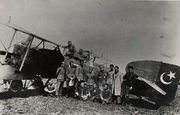
The Ottoman Air Force was closed by the Ottoman Ministry of War and all personnel were formally discharged. The Ottoman pilots were thus left without planes and proper assistance and the period of Ottoman military aviation ended. During the Turkish War of Independence, Turkish pilots joined the Konya Hava Istasyonu (Konya Air Station). With the opening of the Grand National Assembly in 1920 in Ankara and the reorganization of an ordered Army, the Kuva-yı Havaiye (Air Force) bound to the Harbiye Dairesi (Ministry of War bound to the TBMM) was established.[4] A few damaged aircraft belonging to the Grand National Assembly were repaired, and afterwards used in combat.
In 1921, the Hava Kuvvetleri (Kuva-yı Havaiye) Şubesi air force section was renamed as Hava Kuvvetleri Genel Müdürlüğü, or the Air Force General Command.[4]
1923-1940
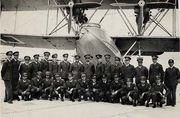
After the proclamation of independence and sovereignty with the Treaty of Lausanne and the establishment of the Republic of Turkey by Mustafa Kemal Atatürk in 1923, approaches were made to form a modern Air Force. Originally consisting of 3 normal and 1 naval aviation units, and an Air Force Academy, the number of units was increased to 10 normal and 3 naval aviation units.[5] Starting in 1924, personnel were sent abroad for flight education.[5] In 1925 the Air Force Academy was reestablished in Eskişehir and its first students graduated in that same year.[5] The Air Force was reorganized in 1928 and new schools were found for non-pilot personnel.[5] Additional to the personnel sent to England and France, other personnel were sent to the USA and Italy in 1930.[5]
On July 1, 1932, the Air Force became a separate combat arm and started training its own personnel.[5] The blue uniforms worn by the Air Force were established in 1933.[5] In 1934 the first Turkish airplanes were produced in Kayseri. Still in 1934 the Türkkuşu (Turkishbird) aviation and parachute society was established, and in 1936 Sabiha Gökçen joined the Turkish Air Force - she became the world's first female combat pilot in 1937. Throughout her career in the Turkish Air Force, Gökçen flew 22 different types of aircraft for more than 8000 hours, 32 hours of which were active combat and bombardment missions.[6] She was selected as the only female pilot for the poster of "The 20 Greatest Aviators in History" prepared by the USAF in 1996.[6] Another key event in 1937 was the establishment of the Hava Harp Akademisi (Air War Academy).[5]
1940 - Present

By 1940, Turkish Air Force had more than 500 combat aircraft in its inventory, becoming the largest Air Force on the Balkans and the Middle East.[5] The growing inventory of the Air Force required another structural change, which was made in 1940.[5] The Air Force under the Milli Savunma Bakanlığı (Ministry of National Defense) for logistical affairs and the General Staff for educational affairs were united to form the Hava Kuvvetleri Komutanlığı (Air Force Command).[5] Thus, the Air Force became a separate branch of the Turkish Armed Forces.[7] The first commander-in-chief was General Zeki Doğan.[7]
Even though Turkey did not enter the Second World War on the side of the Allies until February 1945 (in accordance with the agreements made during the Second Cairo Conference), the Turkish Armed Forces went on full alert and was prepared for war following the military alliance between neighbouring Bulgaria and the Axis Powers which was in essence established with the Treaty of Craiova in September 1940 and formalized in March 1941, and the occupation of neighbouring Greece by the Axis Powers in April 1941. Within a year, Turkey's borders were surrounded by German forces in the northwest and west, and Italian forces in the southwest. Turkish Air Force made daily reconnaissance flights over Bulgaria, Greece, the Greek Islands in the Aegean Sea, and the Dodecanese Islands which then belonged to Italy, for controlling the positions of the Axis forces. The large cities in western Turkey were darkened at nights, and anti-aircraft guns, aided by spot lights, controlled the skies for possible enemy planes. A war economy was imposed, and basic commodities including food and bread were rationed in preparation for the worst-case scenario. Almost all available money in the Turkish Government Treasury was used to purchase new weapons from any available provider in the world. Turkish Air Force received large numbers of new aircraft in this period, including Supermarine Spitfire Mk.I/V/IX/XIX, Curtiss Falcon CW-22R/B, Fairey Battle-I, Avro Anson-I, Hawker Hurricane I/II, Morane Saulnier MS-406, Curtiss P-40 Tomahawk, Curtiss P-40 Kittyhawk, Westland Lysander-I, Consolidated Liberator 3B-24D, Bristol Blenheim IV/V, Bristol Beaufort, Bristol Beaufighter Mk.I/X, Focke Wulf FW-190-A3, Martin Baltimore-187, De Havilland DH-98 Mk.III/IV, B-26B/C Invader, P-47D Thunderbolt and C-47A/B Dakota.
The Hava Teknik Okullar Komutanlığı (Air Force Technical School Command) was founded in 1950 to unite schools responsible for training non-pilot Air Force personnel.[7] In 1950 it also was decided to upgrade the Air Force fleet through the inclusion of jets.[7] Eight pilots were sent to the USA to receive flight education.[7] They graduated in 1951 and started training jet-pilots in the Turkish Air Force.[7] In the same year, the 9th Fighter Wing (9uncu Ana Jet Üssü) was founded in Balıkesir as Turkey's first fighter wing; the 191st, 192nd, and 193rd squadrons being the first ones which were established.[7] Further training in the United States followed, usually involving jet manufacturers.
In the Korean War, Turkish pilots were assigned with reconnaissance missions.
Upon Turkey's inclusion in NATO in 1952, the process of modernization was accelerated.[7]
In 1956 the Hava Eğitim Kolordu Komutanlığı (Air Education Corps Command) was founded and all education was united under this command. The command was renamed as Hava Eğitim Komutanlığı (Air Education Command) in 1957.[7]
In 1962 the Taktik Hava Kuvveti (Tactical Air Force) was founded by upgrading the Hava Tümens (an air unit) to a corps-level organization.
In 1974 the Air Force was employed in the Cyprus War.[7]
With the arrival of 3rd generation fighter jets in 1980, the Air Force was reorganized.[7]
The Turkish Air Force took part in the Operation Deliberate Force of 1995 and Operation Allied Force of 1999, and later participated in the UN peacekeeping mission in Bosnia-Herzegovina, employing two squadrons (one in the Ghedi fighter wing, and after 2000 one in the Aviano fighter wing).[7] They returned to Turkey in 2001. In 2006, 4 Turkish F-16 fighter jets were deployed for NATO's Baltic Air Policing operation.
NATO
NATO nuclear sharing
Turkey is one of five NATO member states which are part of the nuclear sharing policy of the alliance, together with Belgium, Germany, Italy and the Netherlands.[8] A total of 90 B61 nuclear bombs are hosted at the Incirlik Air Base, 40 of which are allocated for use by the Turkish Air Force in case of a nuclear conflict, but their use requires the approval of NATO.[9]
However there is no permanent nuclear capable force of F-16s based at Incirlik, also the Turkish Air Force is not certified for NATO nuclear missions. Thus if Turkeys 40 B61 nuclear bombs were needed, NATO would first need delivery of nuclear capable F-16s from U.S. air bases in western europe to deliver the bombs. "The reason for this situation is that NATO no longer uses tactical nuclear weapons. Thus if the Turkish allocation of nuclear weapons were ever needed, it would take 'months' to ready them." This would also result in the B61 nuclear bombs being delivered by U.S pilots flying U.S nuclear capable F-16s. [10]
As of 2010 the United States has considered withdrawing these nuclear bombs from Turkey, and from several other foreign locations in Europe.[11]
NATO Allied Air Component Command Izmir
Since August 11, 2004, the headquarters of NATO's Allied Air Component Command for Southern Europe, formerly known as AIRSOUTH, is located in İzmir, Turkey.[12]
The NATO CC-Air HQ Izmir is bound to the Allied Joint Force Command Naples based in Naples, Italy.[13]
Modernization projects
Combat aircraft

In 1984 the Turkish Aerospace Industries (TAI) was established and Turkey started to locally produce fighter aircraft under license; including a total of 232 F-16 Fighting Falcon (Block 30/40/50) aircraft for the Turkish Air Force. The TuAF had previously received 8 F-16s that were directly purchased from the United States, bringing the number of total F-16s received by the Turkish Air Force to 240.[16] TAI is currently building 30 new F-16 Block 50+ aircraft for the TuAF[17][18] and is applying a CCIP upgrade on the existing fleet of Block 30/40/50 F-16s, which will bring all of them to the Block 50+ standard.[16][19][20][21] Dozens of TAI-built F-16s were also exported to other countries, particularly in the Middle East. A total of 46 TAI-built F-16s have been exported to the Egyptian Air Force under the Peace Vector IV Program (1993–1995), making it TAI's second-largest F-16 customer after the Turkish Air Force.[22] Turkey is one of only five countries in the world which locally produce the F-16 Fighting Falcon.[16]
The Turkish Armed Forces has initiated a $160 billion (excluding the yearly military budget) modernization program in 1997. $45 billion is earmarked to go to the overhaul of the Turkish Air Force. As part of this program, Ankara aims to commission new combat aircraft (consisting of F-16 CCIP Block 50+, F-35 Lightning II and possibly also the Eurofighter Typhoon)[23] and helicopters (consisting of heavy lift, attack, medium lift and light general purpose helicopters).
On July 11, 2002 Turkey became a Level 3 partner of the F-35 Joint Strike Fighter (JSF) development program, and on January 25, 2007, Turkey officially joined the production phase of the JSF program, agreeing to initially purchase 116[14][15] F-35A Lightning II aircraft.[23]
Aerial refueling tanker aircraft
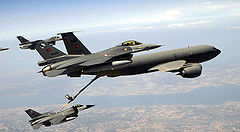
In 1994 the Turkish Air Force leased two KC-135R Stratotanker aircraft from the United States, and signed a deal to purchase seven KC-135R-CRAG Stratotanker aerial refueling tanker aircraft.[24] Following the arrival of all seven purchased aircraft, the two leased KC-135Rs were returned back to the United States.[24] The KC-135R-CRAG Stratotanker aerial refueling tanker aircraft of the Turkish Air Force are operated by the 101st Squadron, stationed at the Incirlik Air Base.[24]
Turkey is also a partner nation in the Airbus A400M program. Although the A400M is essentially a heavy tactical lift aircraft, it can also be transformed into a tanker aircraft for aerial refueling at short notice. The TuAF has ordered a total of ten A400M aircraft.[25]
Airborne Early Warning & Control (AEW&C) aircraft
A total of four Boeing 737 AEW&C MESA Peace Eagle aircraft (together with ground support systems) were ordered by the Turkish Air Force, with an option for two more aircraft. Turkish Aerospace Industries (TAI) is the primary subcontractor for the Peace Eagle parts production, aircraft modification, assembly and tests. Another subcontractor, Havelsan, is responsible for system analysis and software support.[26]
Peace Eagle 1 is modified and tested by Boeing Integrated Defense Systems in Seattle, WA, USA. Peace Eagle 2, 3 and 4 are modified and tested at the facilities of TAI in Ankara, Turkey, with the participation of Boeing and a number of Turkish companies. As of 2006, the four Peace Eagle airplanes were scheduled to be delivered in 2008.[27] As of mid-2007, systems integration was ongoing and airworthiness certification works continued. In September 2007, Boeing completed the first test flight of Turkey's AEW&C 737.[28]
On 4 June 2008, it was announced that Turkish Aerospace Industries completed the first in-country modification of a Boeing 737-700 into an Airborne Early Warning and Control (AEW&C) platform for Turkey’s Peace Eagle program.[29]
Satellites
Turkey plans to acquire new military/intelligence satellites in the short term. These include a 0.8m resolution reconnaissance satellite (Project Göktürk-1) for use by the Turkish Armed Forces and a 2m resolution reconnaissance satellite (Project Göktürk-2) for use by the Turkish National Intelligence Organization. Göktürk-2 is currently being produced by the Turkish Aerospace Industries, while Göktürk-1 is in the tender stage. Some electro-optical parts that are required for the Göktürk-1 (0.8m resolution) satellite are beyond TAI's technological know-how, thus a foreign partner is being sought. The official bidders for the project are EADS Astrium (U.K.), OHB-System (Germany) and Telespazio (Italy).[30]
High altitude ballistic missile defence shield
Havelsan of Turkey and Boeing of the United States are in the process of developing a next generation, high altitude ballistic missile defence shield. It is envisaged that the system will be used by the U.S., Turkey and other NATO member states.[31][32][33]
Operational experience
The Turkish Air Force has taken part in numerous battles and operations, including:
- The Balkan Wars (1912-1913)
- First World War (1914-1918)
- Turkish War of Independence (1919-1922)
- Korean War (1950-1953)
- Cyprus War (1974)
- Operation Provide Comfort (1991-1996)
- Operation Deliberate Force (1995)
- Operation Northern Watch (1997-2003)
- Operation Allied Force (1999)
- Operation Enduring Freedom (2001-present)
- Operation Northern Iraq (2007-2008)
- Operation Sun (2008)
Notabilities
- Sabiha Gökçen was the first Turkish female aviator and combat pilot. She joined the Turkish Air Force in 1936 and in 1937 took part in the military operation to put down the Dersim Revolt, thus becoming the world's first female air force pilot with battle experience. Throughout her career in the Turkish Air Force, which lasted until 1964, Gökçen flew 22 different types of aircraft for more than 8000 hours, 32 of which were active combat and bombardment missions.[34] She was selected as the only female pilot for the poster of "The 20 Greatest Aviators in History" published by the United States Air Force in 1996.[34]
- Turkey provided 18 F-16s for the NATO campaign against Serbia during Operation Allied Force in 1999. Of these, 11 TAI-built F-16s were stationed at the NATO base in Aviano, Italy, while the other 7 were based in Ankara, Turkey. All were equipped with laser-guided bombs using the LANTIRN night vision system. Turkish jets had previously patrolled Balkan airspace, providing protection for attacking aircraft. During this allied air campaign, TAI-built F-16s set a world CAP record by patrolling for 9 hours and 22 minutes above the Balkan theatre. Normally, CAP missions last between 3 to 4 hours.
- In December 2007, the Turkish Air Force initiated Operation Northern Iraq, which continued until the end of February 2008, eventually becoming a part of Operation Sun. At the initial phase of this operation, on December 16, 2007, the TuAF used the AGM-65 Maverick and AGM-142 Popeye/Have Nap during a night bombardment for the first time.
Structure
- Headquarters, Ankara
- Chief of the Turkish General Staff: General İlker Başbuğ
- Commander of the Turkish Air Force: General Hasan Aksay
-
- Air Force Staff Division Command
- 10th Tanker Base Command, İncirlik, Adana
- KC-135 Stratotanker tanker aircraft
- 11th Air Transportation Main Base Command, Etimesgut, Ankara
- CASA CN-235(T),
- Cessna Citation VII,
- Cessna Citation II (CE-550),
- Gulfstream IV-SP,
- 3 CASA CN-235 (T) ambulance aircraft
- 12th Air Transportation Main Base Command, Erkilet, Kayseri
- C-130 Hercules,
- C-160 Transall and
- CASA CN-235 (T) aircraft
- 10th Tanker Base Command, İncirlik, Adana
- Air Force Staff Division Command
- 1st Tactical Air Force Command, Eskişehir
- 1st Main Jet Base Group Command
- 4th Main Jet Base Group Command
- 6th Main Jet Base Group Command
- 9th Main Jet Base Group Command
- 15th Missile Base Group Command
- 1st Air Control Group Command
- 2nd Tactical Air Force Commands, Diyarbakır
- 5th Main Jet Base Group Command
- 7th Main Jet Base Group Command
- 8th Main Jet Base Group Command
- 2nd Air Control Group. Command
- Air Training Command, Gaziemir, İzmir
- 2nd Main Jet Base Group Command
- 3rd Main Jet Base Group Command
- Air Force Academy Command
- Air Corps Schools and Technical Training Center Command
- Air Language School and Airmen Training Brigade Command
- Air Logistics Command, Etimesgut, Ankara
- 1st Air Supply and Maintenance Center Command
- 2nd Air Supply and Maintenance Center Command
- 3rd Air Supply and Maintenance Center Command
- Air Museum Command
These commands consist of:[35]
- 19 Combat squadrons
- 1 Reconnaissance squadron
- 6 Training squadrons
- 6 Transportation squadrons
- 1 Tanker squadron
- 8 Surface-to-air missile (SAM) squadrons
Aircraft Inventory
| Aircraft | Origin | Role | Versions | In service[24] | Notes | |
|---|---|---|---|---|---|---|
| Fighter Aircraft | ||||||
| F-16 Fighting Falcon | Multirole Aircraft | Block 40/50/52 | 180 | All going to modernized CCIP level | ||
| F-16 Fighting Falcon | Multirole Aircraft | Block 30 | 30 | Low level modernization by TAI | ||
| F-4E 2020 Terminator | Multirole Aircraft | - | 52 | Modernized by IAI | ||
| F-4E 2000 Şimşek | Multirole Aircraft | - | 48 | Low level modernization by TAI | ||
| F-4 Phantom | Multirole Aircraft | F-4E Phantom | 25 | - | ||
| F-5 Freedom Fighter | Multirole Aircraft | NF-5 | 75 | Low Combat Role using as advanced trainers | ||
| Total Combat Aircraft | 410 | |||||
| Aircraft | Origin | Role | Versions | In service[24] | Notes | |
| Reconnaissance Aircraft | ||||||
| RF-4E | Reconnaissance Aircraft | RF-4E Phantom | 26 | Modernized by TAI under 'Işık' modernization program | ||
| Total Reconnaissance Aircraft | 26 | |||||
| Aircraft | Origin | Role | Versions | In service[24] | Notes | |
| Trainer Aircraft | ||||||
| T-38 Talon | Trainer Aircraft | T-38A Talon | 70 | Modernized by TAI under 'Arı' modernization program | ||
| F-5 2000 | Trainer Aircraft | F-5B | 50 | Modernized by IAI | ||
| T-37 Tweet | Trainer Aircraft | T-37 Tweet | 60 | Going to Phased out | ||
| SF-260 | Trainer Aircraft | SF-260D | 38 | Built by TAI | ||
| T-41 Mescalero | Trainer Aircraft | T-41D Mescalero | 28 | - | ||
| Total Trainer Aircraft | 246 | |||||
| Aircraft | Origin | Role | Versions | In service[24] | Notes | |
| Transport Aircraft | ||||||
| C-130 Hercules | Transport Aircraft | C-130E | 13 | Modernized bu TAI under Erciyes program | ||
| C-160 Transall | Transport Aircraft | C-160T | 20 | Modernized by TAI | ||
| CN-235 | Transport Aircraft | CN-235M-100 | 50 | Built by TAI | ||
| Grumman Gulfstream G550 | VIP Transport | - | 1 | - | ||
| Grumman Gulfstream-IV | VIP Transport | - | 3 | - | ||
| Cessna 550 Citation II | VIP Transport | - | 2 | - | ||
| Cessna 650 Citation VII | VIP Transport | - | 2 | - | ||
| Beech King Air 200 | VIP Transport | - | 1 | - | ||
| Total Transport Aircraft | 92 | |||||
| Aircraft | Origin | Role | Versions | In service[24] | Notes | |
| Tanker Aircraft | ||||||
| KC-135 Stratotanker | Aerial Refueling Tanker | KC-135R-CRAG Stratotanker | 7 | - | ||
| Total Aerial Refueling Aircraft | 7 | |||||
| Aircraft | Origin | Role | Versions | In service[24] | Notes | |
| Airborne Early Warning and Control | ||||||
| B-737-700 AEW&C MESA | AWACS | - | 4 | to be delivered in 2011 under 'Barış Kartalı' program | ||
| Total Early Warning and Control Aircraft | 4 | |||||
| Aircraft | Origin | Role | Versions | In service[24] | Notes | |
| Helicopter | ||||||
| Eurocopter Cougar | Utility Helicopter | AS 532UL Cougar Mk1 | 20 | built by TAI | ||
| UH-1 Huey | Light Utility Helicopter | UH-1H | 80 | - | ||
| Total Helicopter | 100 | |||||
| Aircraft | Origin | Role | Versions | In service[24] | Notes | |
| Unmanned Aerial Vehicle | ||||||
| Harpy | Mini UAV | - | 107 | |||
| Heron | UAV | - | 10 | |||
| MQ-9 Reaper | UAV | - | 4 | Going to delivered under FMS Package | ||
| MQ-1 Predator | UAV | - | 6 | Going to delivered under FMS Package | ||
| I-GNAT ER | Mini UAV | - | 20 | - | ||
| Total Unmanned Aerial Vehicle | 247 | |||||
Air Defense Weapons
| Weapon | Origin | Role | Versions | In service | Notes | |
|---|---|---|---|---|---|---|
| Surface to Air Weapons | ||||||
| MIM-14 | Long Range Air Defense Weapon | Nike-Hercules | 72 Missiles | To be Phased out | ||
| MIM-23 | Medium Range Air Defense Weapon | Hawk XXI | 48 Fire Unit with 16 Battery | - | ||
| Rapier missile | Medium Range Air Defense Weapon | Rapier FSB1 | 86 Battery | Under License of Roketsan | ||
| Atılgan PMADS | Short Range Air Defense Weapon | Zıpkın Variant Mounted on Land Rover Defender | 32 Battery | Under License of Roketsan | ||
| FIM-92 Stinger | MANPADS | - | 108 Launcher | Under License of Roketsan | ||
Future Plans
| Aircraft | Origin | Role | Versions | Planned | Notes |
|---|---|---|---|---|---|
| F-16 Fighting Falcon | Multi Role Fighter | F-16 CCIP | 30 | will be delivered in 2011 | |
| F-35 Lightning II[36] | Stealth Attack Aircraft | F-35A | 120+30 option | Center fuselage of F-35 will be produced in Turkey. After 2013, TAI will also produce 100% of the F-35 under license from Lockheed Martin Corporation. | |
| Eurofighter Typhoon | Multirole Aircraft | EF-2000 Tranche III | 60-80 | Turkey may consider buying some Eurofighters after 2020[37] | |
| A400M | Strategic Transport Aircraft | A400M | 10 | Aircraft is Under License by TAI | |
| TAI Hürkuş | Basic Trainer Aircraft | TAI Hürkuş | 4 prototype will be complete in 2010,no definite order | - | |
| KT-1 | Basic Trainer Aircraft | KT-1T | 40+15 optional will be delivered | - | |
| TIHA | Unmanned Aerial Vehicle | TIHA-A and TIHA-B | Prototype of TIHA-A is ready. | TIHA-B will be armed with missiles | |
| Long Range Air Defense System Project | Air Defense Weapons | Turkey will choose MIM-104, S-400, HQ-9 or Eurosam | Turkish Air Force will buy 4 Battery/16 Fire Unit |
See also
- Turkish Stars
External links
 This article incorporates public domain material from the CIA World Factbook document "2004 edition".
This article incorporates public domain material from the CIA World Factbook document "2004 edition".- Official Turkish Armed Forces Website
- Official Turkish Air Force Website
- Istanbul Technical University Faculty of Aeronautics and Astronautics
References
- ↑ Library of Congress - Federal Research Division (August 2008). "Country Profile: Turkey". p. 25. http://memory.loc.gov/frd/cs/profiles/Turkey.pdf
- ↑ Turkish Air Force: Foundation years
- ↑ Turkish Air Force: 1911-1918
- ↑ 4.0 4.1 4.2 4.3 4.4 Turkish Air Force: 1918-1923
- ↑ 5.00 5.01 5.02 5.03 5.04 5.05 5.06 5.07 5.08 5.09 5.10 Turkish Air Force: 1923-1944
- ↑ 6.0 6.1 "TRT documentary on Sabiha Gökçen". http://www.youtube.com/watch?v=LxvPj4XOeTU.
- ↑ 7.00 7.01 7.02 7.03 7.04 7.05 7.06 7.07 7.08 7.09 7.10 7.11 Turkish Air Force: 1944-Today
- ↑ Der Spiegel: Foreign Minister Wants US Nukes out of Germany (2009-04-10)
- ↑ NRDC: U.S. Nuclear Weapons in Europe • Hans M. Kristensen / Natural Resources Defense Council, 2005.
- ↑ http://exposingliberallies.blogspot.com/2009/11/us-nuclear-weapons-in-turkey.html
- ↑ "Report: US considers withdrawing nuclear bombs from Turkey," Today's Zaman. April 03, 2010.
- ↑ NATO Allied Air Component Command İzmir
- ↑ NATO Allied Air Component Command İzmir: Structure of NATO forces
- ↑ 14.0 14.1 NTV-MSNBC: F-35 uçakları. October 31, 2006.
- ↑ 15.0 15.1 Hürriyet: İlk F-35'te dört Türk parçası uçtu. December 24, 2006.
- ↑ 16.0 16.1 16.2 "F-16.net: Turkish Air Force". http://www.f-16.net/f-16_users_article21.html.
- ↑ "Turkey signs $1.78 bln deal to buy warplanes". Reuters. http://www.reuters.com/article/tnBasicIndustries-SP/idUSL114958220070511.
- ↑ "Turkey signs contract to buy 30 F-16 block 50+ jets". F-16.net. http://www.f-16.net/news_article2325.html.
- ↑ "F-16 Peace Onyx III program kicks off at TAI". F16 Net. July 11, 2007. http://www.f-16.net/news_article2421.html.
- ↑ "$1.1B to Upgrade Turkish F-16 fleet". Defense Industry Daily. http://www.defenseindustrydaily.com/2005/05/11b-to-upgrade-turkish-f16-fleet/index.php.
- ↑ "Contracts". U.S. Dept of Defense. December 22, 2006. http://www.defenselink.mil/Contracts/Contract.aspx?ContractID=3407.
- ↑ Turkish Aerospace Industries: Programs
- ↑ 23.0 23.1 "Despite JSF Pact, Turkey Doesn’t Rule Out Eurofighter Buy". DefenseNews.com. 01/29/07 13:38. http://www.defensenews.com/story.php?F=2509961&C=airwar.
- ↑ 24.00 24.01 24.02 24.03 24.04 24.05 24.06 24.07 24.08 24.09 24.10 Tayyareci: Boeing KC-135R Stratotanker
- ↑ http://www.airbusmilitary.com/performance.html Airbus Military: A400M
- ↑ Peace Eagle (PE) - Turkish Airborne Early Warning & Control System, Havelsan.
- ↑ "Boeing Installs MESA Antenna on First Peace Eagle Aircraft", Boeing, March 2, 2006.
- ↑ "Boeing Successfully Completes First Test Flight of AEW&C Peace Eagle Aircraft", Boeing, September 6, 2007.
- ↑ Frontier India: Turkish Aerospace Industries completes modification of Peace Eagle AEW&C aircraft
- ↑ Undersecretariat for Turkish Defence Industries: Electro-Optical (EO) Reconnaissance and Surveillance Satellite System (GÖKTÜRK)
- ↑ Goliath: Boeing and Havelsan announce missile defence partnership. February 10, 2003.
- ↑ Boeing: Boeing and Turkey's HAVELSAN Renew Missile Defense Partnership. April 22, 2008.
- ↑ Undersecretariat for Turkish Defence Industries: Long Range Air and Missile Defence System Project
- ↑ 34.0 34.1 TRT documentary on Sabiha Gökçen
- ↑ Scramble on the Web: Turkish Air Force - Order of Battle
- ↑ http://www.hurriyetdailynews.com/n.php?n=turkey-may-buy-20-more-f-35-fighters-2009-10-07
- ↑ http://www.hurriyetdailynews.com/n.php?n=turkey-may-buy-20-more-f-35-fighters-2009-10-07
|
||||||||||||||||||||||||||||||||
|
|||||||||||
